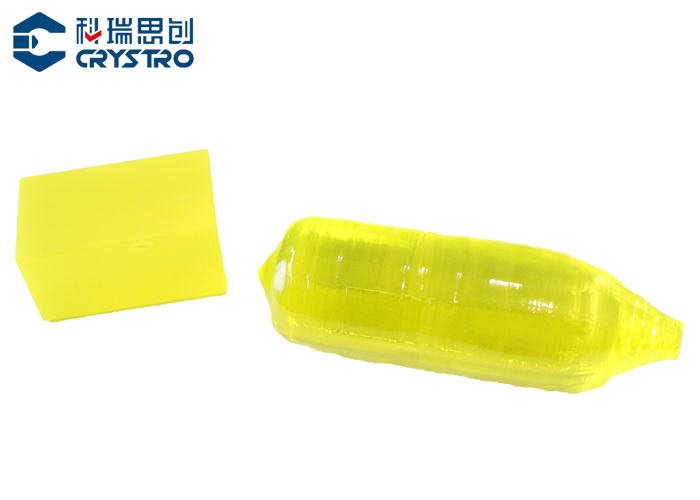Inorganic scintillator crystals are essential components in various fields such as nuclear physics, medical imaging, and security applications. Selecting the right type of crystal involves considering several key factors to ensure optimal performance and compatibility with specific applications. This guide aims to provide an overview of considerations and criteria for selecting inorganic scintillator crystals.
Table of Contents
Key Considerations of Scintillator Crystals
Type of Radiation:
Determine the type of radiation (gamma rays, alpha particles, neutrons, etc.) the crystal will detect. Different crystals have varying sensitivities to different types of radiation.
Energy Resolution:
Energy resolution defines the ability of the crystal to distinguish between different energy levels of incoming radiation. Higher energy resolution is crucial for precise spectroscopy applications.
Light Output and Efficiency:
The light output of the crystal directly affects the efficiency of photon detection. Higher light output enhances sensitivity and reduces detection limits.
Mechanical and Chemical Stability:
Consider the environmental conditions where the crystal will operate. Ensure it has adequate mechanical strength and resistance to chemical degradation or radiation damage, depending on the application.
Scintillation Decay Time:
The decay time determines how quickly the crystal emits light pulses after radiation interaction. Fast decay times are essential for high-speed counting applications.
Size and Shape:
Choose a crystal size and shape that aligns with the detection system's design requirements and integration constraints.

Common Types of Inorganic Scintillator Crystals
NaI(Tl) (Sodium Iodide with Thallium)
Widely used for gamma spectroscopy due to its high light output and relatively good energy resolution.
CsI(Tl) (Cesium Iodide with Thallium)
Offers better energy resolution than NaI(Tl) and is suitable for gamma spectroscopy and medical imaging.
BGO (Bismuth Germanate)
Known for its high density and excellent stopping power, suitable for gamma spectroscopy and high-energy physics.
LYSO (Lutetium Yttrium Orthosilicate)
Provides excellent energy resolution and fast decay time, ideal for positron emission tomography (PET) scanners.
LaBr3(Ce) (Lanthanum Bromide with Cerium)
Offers high light output and fast decay time, preferred for gamma spectroscopy and homeland security applications.
Ce:LuAG (Cerium-doped Lutetium Aluminum Garnet)
Ce:LuAG crystals offer several advantages:
High Density and Atomic Number: Provides excellent stopping power for gamma rays, making it suitable for high-energy physics experiments and gamma spectroscopy.
Good Energy Resolution: Offers competitive energy resolution compared to other scintillator materials, which is crucial for precise spectroscopic measurements.
Chemical and Mechanical Stability: Resistant to chemical and mechanical degradation, ensuring long-term reliability in harsh environments.
Ce:GAGG (Cerium-doped Gadolinium Aluminum Gallium Garnet)
Ce:GAGG crystals also have specific advantages:
High Light Yield: Provides a high number of photons per unit of deposited energy, enhancing detection sensitivity and lowering detection limits.
Fast Scintillation Decay Time: Rapid response to incident radiation, making it suitable for high-count-rate applications and time-of-flight measurements.
Compatibility with Different Radiation Types: Effective for detecting a wide range of radiation types, including gamma rays and charged particles.

Selection Process
Define Application Requirements:
Clearly outline the specific performance requirements such as energy resolution, sensitivity, and environmental conditions.
Compare Performance Characteristics:
Evaluate different crystal types based on their energy resolution, light output, decay time, and compatibility with radiation types.
Consider Cost and Availability:
Factor in the cost per crystal and availability from suppliers, especially for large-scale projects or continuous operation.
Consult with Experts:
Seek advice from experts in the field or crystal manufacturers to ensure the selected crystal meets all necessary criteria for the application.
Conclusion
Selecting the right inorganic scintillator crystal is crucial for achieving optimal performance in radiation detection and imaging systems. By considering factors such as radiation type, energy resolution, light output, and environmental stability, you can effectively choose a crystal that enhances sensitivity, accuracy, and reliability in your specific application.
Whether you're involved in medical diagnostics, nuclear research, or security screening, understanding these selection criteria will facilitate informed decision-making and ensure successful integration of inorganic scintillator crystals into your technology or instrumentation.
